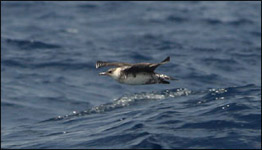
| About the book |
| The Authors |
| Reviews |
| Publisher |
| Photographs |
| Contact us |
However, it is often not enough for us birders just to experience this, we want to find out what we are seeing and which species that are moving through. This book is mainly about that: identifying flying and migrating seabirds and wildfowl in field conditions.
 |
| Pomarine Skua. Photo: Dan Mangsbo |
With 374 pages and more than 690 colour photographs this guide covers all species of seabirds and wildfowl that occurs regularly along the western European seaboard, including many subspecies and most vagrants from southern and arctic waters and North America. These groups of species are represented: divers, grebes, albatrosses, fulmars, petrels, shearwaters, storm-petrels, boobies/gannets, tropicbirds, frigatebirds, cormorants, swans, geese, ducks, mergansers, skuas, gulls, terns and auks.
We endeavour to convey useful field characters for each species. It often a question of jizz rather than small details in silhouettes and plumages. It is also important to remember that we have written from a perspective of field use. A passing bird will only reveal itself for a short moment, you may only have a minute or a few seconds to record characters, and it is thus essential to know exactly what to look for. We hope that you will find this book useful for that purpose, but also that you will find it useful for reference even after the bird has disappeared. We have omitted plumage characters which we consider to be of limited value in the field of flying seabirds, as well as characters which are useful for identification in the hand or when the bird needs to be scrutinised at length. There are already a number of books covering these aspects in adequate detail.
We hope that this book will help increase an already growing number of seawatchers. Being amongst a group of observers at a seawatching site, not only allows you to share great experiences, but also to discuss features and advance the field identification of seabirds. We also hope that birders already hooked on seawatching will find useful information in the book. Seawatching is not just instructive and interesting, but also great fun and an exciting and sometimes overwhelming experience. And the unexpected always lurks around the corner...
Anders, Bertil & Niklas
Copyright © 1999-2013– All rights reserved